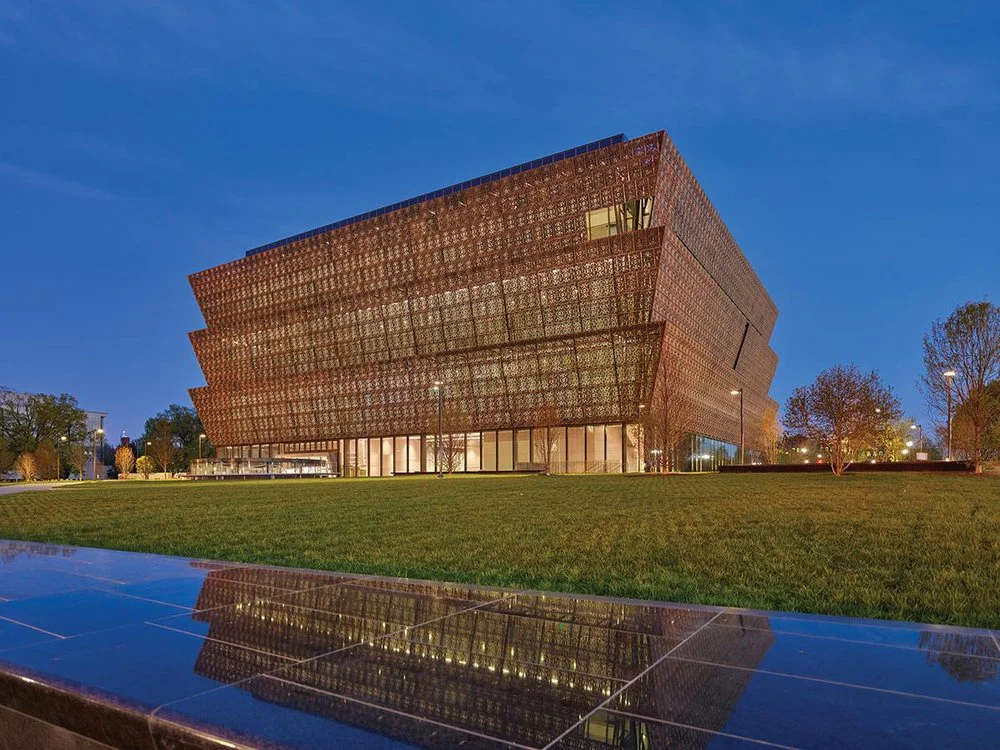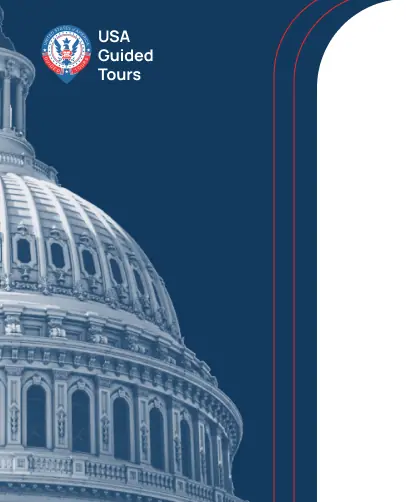February has officially started, which means it is Black History Month! This annual observance is a time to pause and reflect on the contributions that African-Americans have made to American culture. Washington DC has a very prominent history for black people in America and we are honored to offer our African American History & Culture Tour to share that history with the Capital’s visitors! Additionally, our tour concludes at the newest Smithsonian museum, whose focus is honoring black history in America.
This month is not only about recognizing our past but also about looking to the future, so we will highlight icons who can inspire future generations of young people of color. Before we delve into their lives, we wanted to review the history.
Africans were first brought to the New World as slaves when Spanish and Portuguese explorers settled in Central and South America as well as the Caribbean. It is estimated that 275,000 Africans (free and slave) lived in this area by the year 1600.
In 1619, Africans would first arrive in what would later become the United States. A century after Africans were first brought across the Atlantic, over six million Africans lived in North America. Circumstances would remain largely unchanged for blacks in America for generations. Before the American Revolution, slavery was present in every colony. Eventually, the northern states would abandon the practice due to the ideals that were established by America’s Founding Fathers. In the South, however, slavery was highly profitable for tobacco and cotton farmers. It was at this time that the majority of American blacks were located in the South, and nearly all were enslaved. Brave leaders such as Harriet Tubman risked their well-being and lives by utilizing what became known as the Underground Railroad to help those who were enslaved escape to Canada when northern states did not provide adequate protection.
While there were some attempts by blacks to oppose the harsh treatments inflicted upon them by Southerners, it wasn’t until 1861 when the American Civil War broke out that African-Americans stood a chance at fighting for their freedoms. With it, President Abraham Lincoln ushered in a new age for black Americans with the Emancipation Proclamation, a directive that finally abolished slavery throughout the entirety of the country.
Even after blacks were freed, however, their difficulties continued. Segregation and prejudice would plague the land for nearly a century after slavery ended. It wasn’t until the American Civil Rights movement that lasted from 1954-1968 that Blacks began gaining traction for equal treatment and rights. Figures like Martin Luther King, Jr. helped make tremendous strides for African-Americans and would cement him as a powerful symbol in American culture. What was achieved by the black community (and those who supported them) formed the foundation of our culture’s embrace of inclusion and diversity in modern times.
To begin this month’s duty in commemorating history which is often forgotten, we are putting the spotlight on 5 Icons for Black History Month. Scroll down to see our list and check our Instagram @USAGuidedTours for other #BlackHistory content all month long! Contact us to schedule your tour today!
First we will discuss the man who, 97 years ago, designated the week of the birthdays of Frederick Douglass and President Abraham Lincoln as “Negro History Week”. It is because of him that we are honoring the lives and legacies of so many icons during Black History Month.
Born in Virginia to very poor, illiterate parents who had been enslaved. His father was a farmer and a carpenter. Young Carter would read to his parents to bring the world to them. They endured considerable financial sacrifice to prioritize his education. He would teach in West Virginia, then earn his degrees in history at Berea College, Kentucky, and then another bachelor’s degree plus a master’s degree at the University of Chicago. Woodson became only the second African American (after W.E.B. DuBois) to receive a PhD in history from Harvard. He also bears the distinction of being the only child of enslaved parents to receive a PhD. His PhD discussed the economic as well as geographic separation of West Virginia from Virginia during the Civil War.
Woodson taught for 10 years in DC public schools, at the Armstrong Manual Training School. The name of the school has changed to the Friendship Armstrong Academy. Musicians Billy Eckstine and Duke Ellington are among the alumni. Woodson also served as a professor and then Dean of Arts and Science at Howard University.
He is remembered for not just teaching but for his role as the “Father of African American History”. He is considered an educational philosopher whose goal was to foster an understanding of history and encourage a sense of social responsibility in his students He created the Association for Study of African American Life and History which continues to this day as well as a publishing house that would publish intellectual and critical papers by African Americans as well as others. In writing a History of African Diaspora, he was one of the first scholars to study slavery from the point of view of the enslaved – giving voices to those whose stories would otherwise have been forgotten. Until that time, history of the enslaved had been presented from the slaveholders’ point of view.
In February 1926, the first “Negro History Week” was held. This was considered by his peers to have been Woodson’s greatest accomplishment. By inspiring students to learn about the past, they also felt a strong sense of responsibility to bring about change. “Negro History Week” was celebrated in the mid-February to correspond to Lincoln’s birthday – February 12th – and Frederick Douglass’ birthday – February 14th. Kent State University set aside February as Black History Month in 1970 but President Gerald Ford officially designated February as a national event 1976 and it has been recognized ever since.
The Journal of African American History has been continuously published since 1916. He was among the first to create African American labor studies. The University of Virginia established the Carter G Woodson Institute in 1981. Their goal is to promote the study of African and African American history and to encourage research promote societal change through leadership development.
While Dr. Woodson’s “office home” is still closed to tourists, 1538 9th St. NW, purchased for $8000 in 1922 by Woodson, has been among the properties managed by the National Park Service since 2006. In 2015, Carter G. Woodson park was named at the intersection of 9th St, NW, Q St. NW and Rhode Island Ave. NW. Prolific Sculptor Raymond Kaskey (also known for his bas reliefs at the World War II Memorial) cast the statue.
Born in South Carolina to parents who had been enslaved and she had 16 siblings. She walked 5 miles each day to and from school. McLeod attended the Scotia Seminary then attended college with the goal of becoming a missionary in Africa. Eventually she would start both a school and a hospital in Daytona Beach. Bethune served as Florida chapter President of the National Association of Colored Women, ultimately becoming National President. She attended President Coolidge’s Child Welfare Conference and President Hoover, in 1930, appointed Bethune to the White House conference on Child Health. Bethune would found the National Council of Negro Women in 1935. The site of this office is still visible in the 600 block Pennsylvania Avenue, one block east of the US Navy Memorial.
Married to Albertus Bethune, she would teach in Florida. Bethune also conducted prison outreach. While running her school, Bethune created a curriculum suitable for instilling practical skills among its students. The goal was for students to be able to be self-sufficient as they moved into adulthood. The school began with six students. Due to extremely low funds, pencils were made from burned wood and pen ink came from elderberry juice. Eventually donations brought money and equipment as well as an additional 30 students.
Bethune was president of the merger of her school with Cookman Institute for boys. Ultimately this junior college would receive accreditation for a four-year curriculum. During Franklin Roosevelt’s presidency, Bethune was frequently in Washington, D.C. She was a close friend of both Roosevelts. Eleanor sat next to Bethune at a conference in Birmingham, Alabama, despite the discriminatory laws in practice at the time.
Bethune founded a collation of leaders known as the “Black Cabinet”. Most members were men. Eventually, attorney E. Frederic Morrow served for 5 years as Administrative Officer for Special Projects under the Eisenhower Administration. A statue of him can be seen at the Eisenhower memorial on Independence Avenue. Bethune also co-founded the United Negro College Fund in 1944 in order to grant scholarships and job opportunities to African American and other minority students.
To circumvent Florida laws preventing African Americans from going to the beach, Bethune purchased a 2-mile stretch of beach called Paradise Beach. She then sold the properties to African American families. Now the beach is called Bethune-Volusia beach.
Funded by the National Council of Negro Women, a statue of Bethune in Lincoln Park was dedicated in 1974. Activist Dorothy Height lobbied for its funding and eventual placement. This statue was the first monument honoring an African American woman in a public park in Washington, D.C. Thousands attended the unveiling ceremony.
Bromery was born in 1926 in Cumberland, Maryland. He began working as a machinist in Detroit, followed by an enlistment in the US Army Air Corps. He was assigned to the Tuskegee Airmen, flying missions in Italy during the second World War.
He studied geophysics at Howard University and became the first African American professional geophysicist with the US geological survey. Thanks to his aviation abilities and his knowledge geophysics, he was well-suited to conduct airborne exploration gravity surveys over much of the United States. His master’s and PhD degrees were in geophysics and geology. By studying gravity anomalies – caused by different rock densities – he was able to make correlations between aspects of the earth’s magnetic field and minerals occurring in certain formations.
Dr. Bromery joined the faculty at University of Massachusetts (U-Mass), Amherst in 1969 and quickly earned not just university tenure, but the position of Chancellor – only the second African American to lead a predominantly white campus. During his time in this position, Dr. Bromery and other African American faculty established the Committee for the Collegiate Education of Black Students. During his tenure, the university substantially increased enrollment of minority and women students, and increased the numbers of minorities and women among its faculty.
The Bromery Fellowship for minorities continues at Johns Hopkins University, where he wrote his dissertation in geophysics. Also, during his time as President of the Geological Society of America, he established a scholarship for minority students studying the geosciences. Also, he aimed to improve geological hazard education and preparedness throughout the country He was named “Honoree of Distinction” in 1007 by the National Academy of Black Geologists and Geophysicists. He served on the President’s Committee on the National Medal of Science from 2003-2007. He died in 2013. In 2020 the Fine Arts Center at UMass was renamed in honor of Bromery.
Known as “the Black Edison”, he was from Cleveland. Morgan had a sixth-grade education and was largely self-taught. Morgan became an inventor who made vast improvements for public safety through his two best-known inventions. Because he suffered prejudice due to his heritage, he staged a dramatic – and effective – test of his gas mask. With a white actor posing as the inventor, Morgan filled a tent with noxious smoke and waited a dramatic interval to “rescue” the actor. As news of both the event and the device spread, the Cleveland Police department asked to purchase the device.
Cleveland was growing as a city and more sewers needed to be dug. Three trillion tons of natural gas lurked within the gypsum and limestone tunnels beneath Lake Erie. After one natural gas explosion killed 11 in Cleveland, his gas mask came into high demand.
Another instance of Morgan’s ingenuity being used to ensure public safety occurred in the early 1920s. He Morgan witnessed a serious accident between a horse-drawn cart and an automobile in Cleveland. He realized that having two signal lights was not sufficient. He created a traffic light that had a third, “all hold”, amber traffic light. In November of 1923, Morgan was granted the patent for this device. General Electric purchased the idea for $40,000 (worth over $600K in 2023).
She was born in Richmond, Virginia but grew up outside Pittsburgh. Barred from swimming in the YWCA pool due to discrimination, Height fought hard to bring about change to the YWCA.
Barred from attending Barnard College due to a quota limiting African American enrollment to two per year, she would complete her education in New York City: New York University was where she studied educational psychology. She completed post-graduate work at Columbia University in social work.
After spending 3 years working at the New York City department of Welfare, she moved to a counseling job at the YWCA in Harlem. Through this job, she, through a chance encounter, met Mary McLeod Bethune and, subsequently Eleanor Roosevelt via the National Council of Negro Women (NCNW). Also Ms. Height focused on bringing an end to lynching and on restructuring the American criminal system.
In 1939, Height moved to Washington, D.C. to become Executive Director of the Phyllis Wheatley Branch of the DC YWCA. Five years later, she would return to New York City to join the national staff with a focus on Interracial Relations. Her work in this realm included training, writing and working with Public Affairs officials. Also, the Interracial Charter from 1946 committed the YWCA to fight against racial injustice at local, national and international levels.
As an active member of Delta Sigma Theta sorority, Height created training and education programs throughout her life. She was national president of the sorority for 10 years. Throughout she continued working with the YWCA. Eventually, in the 1960s, she took a leave of absence to lead an Action Program for Integration and Desegregation of Community YWCAs.
In 1958, Height became President of the NCNW and would serve in this role for over 30 years. She brought the women’s movement into the civil rights movement and was the only female member of the “Big Six” (which actually included 9 members – Dr. King, Jams Farmer, John Lewis, A. Philip Randolph, Rory Wilkins and Whitney Young.) Wednesdays in Mississippi was a series she pioneered in 1964 to bring women from the north and south into dialogues of understanding. Ms. Height was a key organizer of the March on Washington. She also managed the women’s organization during the event.
Ms. Height was part of the organization that spoke out against the infamous “Tuskegee Syphilis Study”. She also advocated for the addition of the statue of Mary McLeod Bethune in Washington, D.C. Height created the African American Women for Reproductive Freedom organization in 1990. In 1994, she received the Presidential Medal of Freedom. The 90th birthday celebration for Height in Washington, D.C. raised $5M for the mortgage on the NCNW office headquarters.
Height was well known for wearing hats and a musical, “If This Hat Could Talk” based on her memoirs, debuted in 2005. It shares her unique perspective of the civil rights movement, discussing the roles Bethune and Eleanor Roosevelt played in her life and work.
Height sat on the stage at the first inauguration of President Obama in 2009. The following year, Height’s funeral took place at the Washington National Cathedral, with a eulogy delivered by President Obama. Not long after her death, DC shadow representative Eleanor Holmes Norton and then-mayor Vincent Gray petitioned for the former main post office to be named the Dorothy I Height Post Office. This building also houses the NCNW (and the 3rd floor had Matthew Brady’s photography studio where he developed the photos of 19th century presidents, most notably that of Lincoln). This building is visible on our tours, one block from the US Navy Memorial.

Through tears and triumphs, blacks in the United States have left an enduring mark on the story of our nation. If you find yourself in or near Washington, D.C. this month, sign up to be a part of the African American History & Culture Tour offered by USA Guided Tours. This specialty D.C. bus tour will give you a more in-depth account of the history we have outlined here. The tour will end with a self-guided tour inside the Smithsonian’s Museum of African America History and Culture.
We encourage you to ask your tour guide questions to learn as much as you can about African American history and how African Americans have helped form the U.S. into what it is today. We hope you will consider joining us for this special journey in order to more fully appreciate our nation’s history and to help build a bright future moving toward the American Dream.
Terry Cordaro, Washington DC Tour Guide in Collaboration With USA Guided Tours Blogging Team

